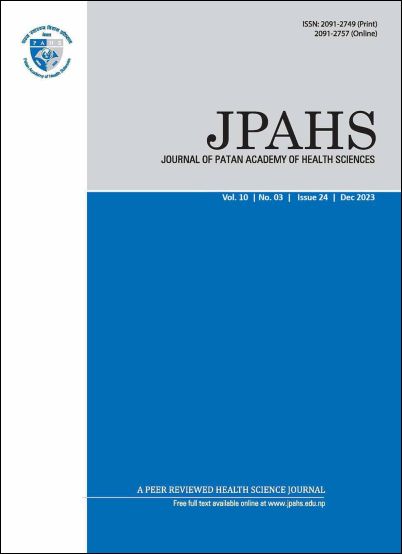Cardiopulmonary resuscitation: knowledge among nurses in selected departments of a teaching hospital, Nepal
DOI:
https://doi.org/10.3126/jpahs.v10i3.58447Keywords:
cardio-pulmonary resuscitation, knowledge, nursesAbstract
Introduction: Cardiopulmonary Resuscitation (CPR) is considered a core emergency skill in which all health care professionals must be proficient. If early basic life support CPR is instantiated, the survival rate is improved. This study aims to assess the knowledge regarding CPR among nurses.
Method: A descriptive cross-sectional study design was adopted among 150 nurses in critical care area of Patan Hospital Lalitpur Nepal, from January to April 2023. Researcher developed self-administered structured questionnaire was used for data collection. Statistical Package for Social Sciences (SPSS) version 20 was used for statistical analysis. Ethical approval was taken from the Institutional Review Committee of Patan Academy of Health Sciences.
Result: Study revealed that majority 143(95.3%) of the respondents had knowledge regarding meaning of sudden cardiac death. Same as 137(91.3%) knew the indication of CPR and most of the respondents 140(93.3%) knew the carotid pulse should be checked before starting CPR. More than half 131(87.3%) had knowledge regarding ratio of chest compression. We found more than half respondents 83(55.3%) knew the best time to switch. Nearly half of the respondents 61(40%) knew the component of high-quality CPR whereas minority of the respondents; 20(13.3%) knew the algorithm of adult cardiac arrest.
Conclusion: Majority of the respondents had knowledge regarding meaning, indication, site of pulse taking, and ratio of chest compression. Whereas more than fifty percent respondents had knowledge regarding, best time to switch, nearly half of respondents knew the components of CPR. Minority of respondents aware the algorithm of adult cardiac arrest.
Downloads
Downloads
Published
How to Cite
Issue
Section
License
© Journal of Patan Academy of Health Sciences
Submission of the manuscript means that the authors agree to assign exclusive copyright to JPAHS. All authors must sign a Copyright Transfer and Author Agreement form upon submission of the manuscript to the Journal. The work shall not be published elsewhere in any language without the written consent of JPAHS. The articles published in this journal are protected by copyright which covers translation rights and the exclusive rights to reproduce and distribute all of the articles printed in the journal.




